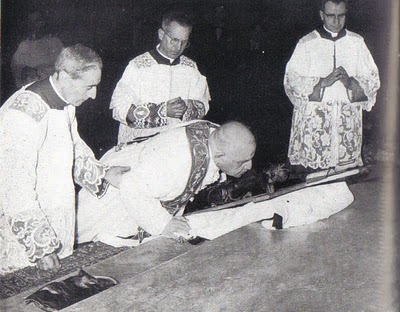Most Catholics would associate the text Pange Ligua with the hymn for the feast of Corpus Christi by the Angelic Doctor of the Church, St Thomas Aquinas. It is however, from the much earlier chant Pange Lingua by Venantius Fortunatus (530-609) that St Thomas took inspiration. It is worth pondering in this the true nature of tradition: development in seamless continuity with what has been handed down.
The original hymn is used in several ways in the liturgy of Passiontide, the first five stanzas appearing in the office of Matins (and reappear on the feasts of the finding and the exaltation of the Holy Cross) and the final five in the office of Lauds. The whole hymn is sung during the veneration of the Cross on Good Friday. The portion ‘Crux Fidelis’
offers a beautiful refrain when alternated with the original stanzas and the hymn ends with a doxology that was added later.
There is so much that is theologically rich in this text that a short post is insufficient. The only observation that may be less familiar is that of Mrs Elizabeth Rundle Charles in her book ‘The Voice of Christian Life in Song’ from which the following quote relating an ancient tradition on the Cross is taken.
“When Adam died, Seth obtained from the guardian cherubim of Paradise a branch of the tree from which Eve ate the forbidden fruit. This he planted on Golgotha, called the place of the scull, because Adam was buried there. From this tree, as the ages rolled on, were made the ark of the testimony, the pole on which the brazen serpent was lifted up, and other instruments; and from its wood, at length, then grown old and hard, was made the Cross.”
| PANGE, lingua, gloriosi proelium certaminis,1 et super Crucis trophaeo dic triumphum nobilem, qualiter Redemptor orbis immolatus vicerit. | SING, my tongue, the Savior’s glory; tell His triumph far and wide; tell aloud the famous story of His body crucified; how upon the cross a victim, vanquishing in death, He died. |
| De parentis protoplasti fraude Factor condolens, quando pomi noxialis morte morsu corruit,2 ipse lignum tunc notavit, damna ligni ut solveret. | Eating of the tree forbidden, man had sunk in Satan’s snare, when our pitying Creator did this second tree prepare; destined, many ages later, that first evil to repair. |
| Hoc opus nostrae salutis ordo depoposcerat, multiformis proditoris ars ut artem falleret, et medelam ferret inde, hostis unde laeserat. | Such the order God appointed when for sin He would atone; to the serpent thus opposing schemes yet deeper than his own; thence the remedy procuring, whence the fatal wound had come. |
| Quando venit ergo sacri plenitudo temporis, missus est ab arce Patris natus, orbis, Conditor, atque ventre virginali carne factus prodiit.3 | So when now at length the fullness of the sacred time drew nigh, then the Son, the world’s Creator, left his Father’s throne on high; from a virgin’s womb appearing, clothed in our mortality. |
| Vagit infans inter arcta conditus praesepia: membra pannis involuta Virgo Mater alligat: et manus pedesque et crura4 stricta cingit fascia. | All within a lowly manger, lo, a tender babe He lies! see his gentle Virgin Mother lull to sleep his infant cries! while the limbs of God incarnate round with swathing bands she ties. |
| LUSTRA sex qui iam peracta5 tempus implens corporis, se volente, natus ad hoc,6 passioni deditus, Agnus in crucis levatur immolandus stipite. | THUS did Christ to perfect manhood in our mortal flesh attain: then of His free choice He goeth to a death of bitter pain; and as a lamb, upon the altar of the cross, for us is slain. |
| En acetum, fel, arundo, sputa, clavi, lancea: mite corpus perforatur, Sanguis, unda profluit7 terra, pontus, astra, mundus, quo lavantur flumine! | Lo, with gall His thirst He quenches! see the thorns upon His brow! nails His tender flesh are rending! see His side is opened now! whence, to cleanse the whole creation, streams of blood and water flow. |
| CRUX fidelis, inter omnes arbor una nobilis; nulla talem silva profert, flore, fronde, germine. Dulce lignum, dulci clavo,8 dulce pondus sustinens! | FAITHFUL Cross! above all other, one and only noble Tree! None in foliage, none in blossom, none in fruit thy peers may be; sweetest wood and sweetest iron! Sweetest Weight is hung on thee! |
| Flecte ramos, arbor alta, tensa laxa viscera, et rigor lentescat ille, quem dedit nativitas, ut superni membra Regis miti tendas stipite.9 | Lofty tree, bend down thy branches, to embrace thy sacred load; oh, relax the native tension of that all too rigid wood; gently, gently bear the members of thy dying King and God. |
| Sola digna tu fuisti ferre saeculi pretium, atque portum praeparare nauta mundo naufrago, quem sacer cruor perunxit,10 fusus Agni corpore. | Tree, which solely wast found worthy the world’s Victim to sustain. harbor from the raging tempest! ark, that saved the world again! Tree, with sacred blood anointed of the Lamb for sinners slain. |
| Aequa Patri Filioque, inclito Paraclito, sempiterna sit beatae Trinitati gloria, cuius alma nos redemit atque servat gratia. Amen.11 | Blessing, honor, everlasting, to the immortal Deity; to the Father, Son, and Spirit, equal praises ever be; glory through the earth and heaven to Trinity in Unity. Amen. |
